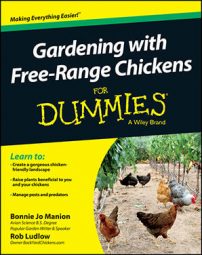No matter how your land lays out, you have many different options for free-ranging chickens. The best method for you depends on your lifestyle, your garden landscape, your property setting, and how you want to raise and manage your chickens. Free-range can be divided into two basic categories, free-range and confined-range.
Here are some details for each type of free-ranging method:
Free-range in the garden all the time: In this option, a chicken coop and secure outside pen are located in a perfect spot in the garden. Gardeners create a perfect layering of landscape and plant materials or ecosystem. Chickens are allowed to free-range throughout the garden and landscape all day. This setting provides them supplemental food, shelter, and protection from predators.
In return, chickens forage, eat pests and weeds, and aerate and fertilize the garden. Chickens naturally return to the coop for egg laying, feed, and at nighttime to sleep. At dusk, the chicken coop is closed and securely locked for the night. In cases of bad weather, or when owners are on vacation, the chickens are confined to their coop and secure outside pen.
Free-range in the garden part time: This variation is the same as free-range all the time, except the owner lets chickens free-range part time or on weekends, and when the owners are around. When chickens are not free-ranging, they have movement and safety within the confines of their chicken coop and secure outside pen, which is protected on all sides.
For most, a confined-range method works best for managing and caring for your chickens, and still maintaining a beautiful and bountiful landscape.
Confined free-range with rotating permanent runs or zones: These are permanent runs that allow chickens to be rotated throughout the year. Chickens can forage and range in these runs seasonally, or when needed. Small chicken gates open from a central chicken coop area.
Chickens have access throughout the day to their feed bucket, waterer, and nesting boxes from the runs. Each run has plants for shelter and protections from predators. Example runs are an enclosed orchard, a berry patch, or a section of your garden.
Confined free-range with temporary runs: With this method, you have temporary fencing and chicken containment for a small period of time such as a day or afternoon. You can use temporary chicken runs to do a certain job, such as turning over a compost area or mowing a lawn. Chickens are confined to free-ranging in a temporary spot, for short term situations.
Confined free-range with mobile chicken coops: A chicken flock pastures during the day and has a chicken coop that’s mobile and accessible during the day. The chickens can be closed in their mobile chicken coop at night. Protection against predators is necessary and extremely important as the flock is in an open environment with little shelter landscape.
This method is usually accompanied with a trained dog to protect and temporary perimeter fencing, such as electrical fencing. Chickens can be easily moved and relocated to another section of a pasture. This method is practiced in rural areas that have larger flocks.
Confined free-range with mobile chicken tractors: These mobile chicken tractors usually have no floor. Chickens are confined within the chicken tractor, with some type of secured wired fencing. They’re usually on a smaller scale for ease of mobility. These tractors can be permanent, but most are temporary chicken housing. These tractors are great for versatility. Chickens have protection, food, and water, and can forage at the same time.

